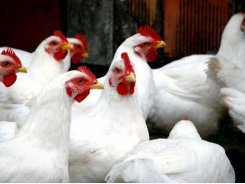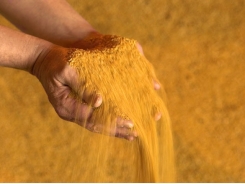Fatty acid content of egg yolks on researchers radar

Researchers with Pennsylvania State University explored the interaction of dietary high-oleic acid soybean oil (HOSO) and high-a-linolenic acid (ALA) flaxseed oil on the polyunsaturated fatty acid content of eggs yolks.
The group published its work in the journal Lipids. Photo: GettyImages/eakkachaister
The researchers hypothesized lowering levels of linoleic acid (LNA) in poultry diets would improve a bird’s conversion of ALA to long-chain fatty acids or omega-3 (n-3) polyunsaturated fatty acids (PUFA).
Chickens can synthesize EPA and DHA from ALA, but the process is inefficient and is inhibited by dietary linoleic acid (LNA).
The goal of the project was to better understand lipid metabolism and ways to improve the enrichment of eggs with omega-3 fatty acids and oleic acid, said Robert Elkin, corresponding author, professor of avian nutritional biochemistry and director of graduate studies at Pennsylvania State University.
“We continue to look for novel dietary approaches to enrich poultry meat and eggs with n-3 fatty acids,” he told FeedNavigator. “We selected HOSO for two reasons: (1) we wanted to enrich eggs with even more oleic acid than is normally present, because of the putative health benefits of this fatty acid (e.g., as a component of the heart-healthy Mediterranean Diet), and with the assumption (now disproven) that oleic acid was ‘metabolically neutral’ relative to n-3 fatty acid metabolism.”
However, the results from the feeding trial were somewhat unexpected, as adding high-oleic acid (OLA) to the diets had a negative effect on the omega-3 fatty acid enrichment of the eggs, he said. The implication of the project is that the research team discovered a potential hindrance to enriching eggs with omega-3 fatty acids.
“Although our finding will not trigger a wholesale reconsideration of approaches to n-3 fatty acid enrichment of chicken meat and eggs, it highlights that in addition to a known attenuator of egg and tissue n-3 fatty acid enrichment – namely linoleic acid – oleic acid may also attenuate n-3 fatty acid enrichment of poultry meat and eggs if co-fed with flaxseed oil (or possibly with fish, fish oil, or microalgae oil),” said Elkin.
Enriching poultry diets
The inquiry into the use of HOSO, ALA and reduction of LNA in poultry diets is the most recent piece of ongoing research examining types of enriched soybean oil and omega-3 fatty acid enrichment in poultry and eggs, said Elkin.
“Some of the first studies Kevin [Harvatine] and I conducted after the SDA work involved another GMO oil, namely high-oleic soybean oil (HOSO),” he said. “Although the focus of our work was to further enrich eggs with both n-3 fatty acids and oleic acid, assuming that oleic acid would be ‘metabolically neutral’ with regard to n-3 fatty acid metabolism, we unexpectedly observed that oleic acid attenuated the deposition of n-3 fatty acids into eggs.”
The research group has continued to explore the interactions for broiler chickens and laying hens, he said. Analysis of the fatty acids continues.
The project was funded through a grant from the PA Soybean Board.
Feeding trials
In the feeding trial, groups of hens were given one of four diets for a period of 12 weeks, the researchers said. The diets included 0, 10, 20 or 40g HOSO/kg and increasing levels of high-a-linoleic acid (ALA) flaxseed oil (FLAX).
Levels of FLAX were raised every three weeks from 0 to 10, to 20 to 40 g/kg in the diet, they said.
Egg yolk contents were analyzed for composition, they said.
Unexpected results
The group found that the high-oleic acid (OLA) was not neutral in how it interacted with the process through which dietary ALA is absorbed, metabolized and deposited into an egg yolk – either as an omega-3 or intact.
When compared to eggs from hens getting the control diets, dietary FLAX enriched the omega-3 level and very long chain n-3 PUFA by 9.4-fold and 2.2-fold, respectively, they said. However, hens getting a diet with 40g of HOSO/kg in the diet saw levels of ALA, VLC n-3 PUFA and total n-3 PUFA in the egg yolk reduced by 37, 15, and 32%, respectively.
It was not the result expected from the intimal hypothesis, said Elkin.
“The finding was totally unexpected, especially the magnitude of the attenuation of omega-3 fatty acid enrichment of eggs,” he said. “So, yes, it was a surprise.”
The mechanism involved is thought to be that oleic acid is more competitive for absorption in the intestine, he said.
“The mechanism is hypothesized to be different in that linoleic acid competes with alpha-linolenic acid for liver desaturase and elongase enzymes involved in the biosynthesis of the heart-healthy long-chain n-3 fatty acids EPA and DHA, while we are hypothesizing that oleic acid ‘out competes’ alpha-linolenic acid for absorption from the intestine, thereby reducing the amount of substrate that reaches the liver for further elongation and desaturation to form EPA and DHA,” he said.
Looking forward, the research team is planning to confirm its findings for HOSO using another high-oleic fatty acid-enriched oil to clarify that what was observed was an “oleic acid effect” and not specifically linked to HOSO, said Elkin. “In that regard, studies have been conducted and we are currently compiling the egg and tissue fatty acid data,” he added.
“Another interesting study would be to demonstrate, either in vitro or in vivo, that oleic acid actually reduces the amount of n-3 fatty acids absorbed from the intestine because it is much more readily absorbed and essentially “out-competes” n-3 fatty acids for uptake from the gut,” he said.
Source: Lipids
Authors: R Elkin, A Kukorowski, Y Ying, K Harvatine
Related news
Tools

Phối trộn thức ăn chăn nuôi

Pha dung dịch thủy canh

Định mức cho tôm ăn

Phối trộn phân bón NPK

Xác định tỷ lệ tôm sống

Chuyển đổi đơn vị phân bón

Xác định công suất sục khí

Chuyển đổi đơn vị tôm

Tính diện tích nhà kính

Tính thể tích ao




 To feed or not to feed? The importance…
To feed or not to feed? The importance…  Mash or crumbled feed for layers?
Mash or crumbled feed for layers?